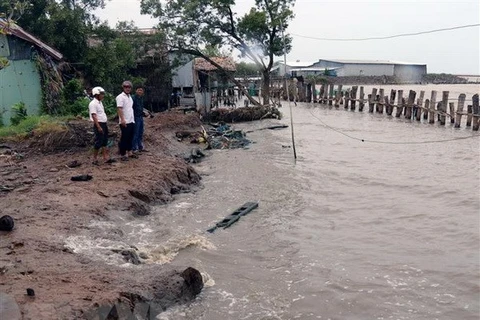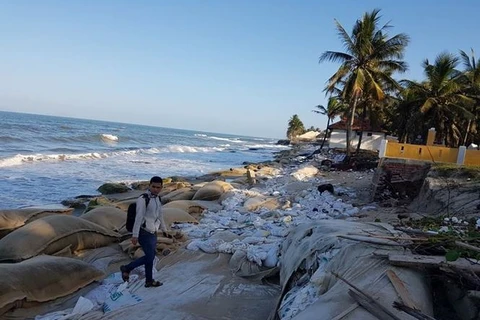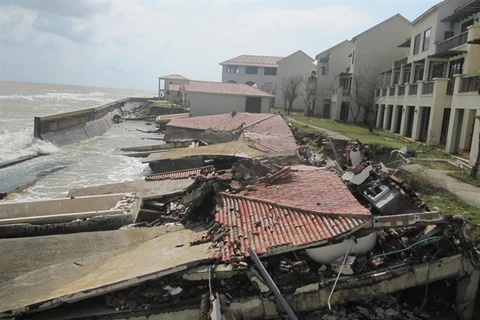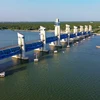Can Tho (VNA) - The Mekong Delta city of Can Tho plans to build concrete embankments in some of the city’s eroded areas, according to Chairman of the municipal People’s Committee Vo Thanh Thong.
Thong and a group of city officials visited the O Mon River in Thoi Lai district’s Thoi Thanh commune on May 14 to inspect erosion levels.
Because the city does not have a sufficient budget to build concrete embankments in all eroded areas, Thong said local authorities should encourage locals to make wooden embankments.
In eroded areas without need for embankments, local residents can plant trees as a preventive measure, he added.
Erosion at the T-junction of the O Mon River and the Rach Tra rivulet mouth has affected roads, a primary school and an old pagoda, according to the city’s Department of Agriculture and Rural Development.
Nguyen Quy Ninh, head of the department’s Irrigation Sub-department, said the river played a crucial role in the city’s waterway transport and many large ships travelling at high speed on the river caused big waves.
The waves hit the riverbank, carving out notches, which has led to erosion in the T-junction area, he said.
The Thoi Lai District People’s Committee has used stakes made from cajuput and coconut trees to set up wooden embankments along the T-junction area, and has planted trees along the river to prevent erosion.
However, these traditional prevention measures have not been effective, according to the district’s People’s Committee.
The department on Tuesday asked the city’s People’s Committee to approve the construction of a 430m long concrete embankment along the T-junction. The cost would be about 50 billion VND (2.14 million USD).
Five erosion cases along rivers and canals have occurred in the city this year, damaging many houses, according to the Irrigation Sub-department.
An erosion case in Vinh Thuan district on April 15, for instance, caused four houses to fall into the Cai San Canal. The total damage was more than 1 billion VND (428,000 USD).
The city has more than 100 erosion–prone sites with a total length of 52.7 kilometres.-VNA
Thong and a group of city officials visited the O Mon River in Thoi Lai district’s Thoi Thanh commune on May 14 to inspect erosion levels.
Because the city does not have a sufficient budget to build concrete embankments in all eroded areas, Thong said local authorities should encourage locals to make wooden embankments.
In eroded areas without need for embankments, local residents can plant trees as a preventive measure, he added.
Erosion at the T-junction of the O Mon River and the Rach Tra rivulet mouth has affected roads, a primary school and an old pagoda, according to the city’s Department of Agriculture and Rural Development.
Nguyen Quy Ninh, head of the department’s Irrigation Sub-department, said the river played a crucial role in the city’s waterway transport and many large ships travelling at high speed on the river caused big waves.
The waves hit the riverbank, carving out notches, which has led to erosion in the T-junction area, he said.
The Thoi Lai District People’s Committee has used stakes made from cajuput and coconut trees to set up wooden embankments along the T-junction area, and has planted trees along the river to prevent erosion.
However, these traditional prevention measures have not been effective, according to the district’s People’s Committee.
The department on Tuesday asked the city’s People’s Committee to approve the construction of a 430m long concrete embankment along the T-junction. The cost would be about 50 billion VND (2.14 million USD).
Five erosion cases along rivers and canals have occurred in the city this year, damaging many houses, according to the Irrigation Sub-department.
An erosion case in Vinh Thuan district on April 15, for instance, caused four houses to fall into the Cai San Canal. The total damage was more than 1 billion VND (428,000 USD).
The city has more than 100 erosion–prone sites with a total length of 52.7 kilometres.-VNA
VNA

























